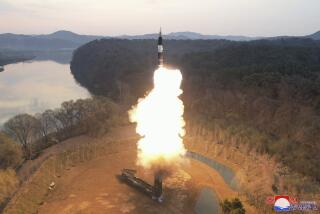Latest missile defense system test is successful
The nation’s trouble-plagued missile defense system registered a success Sunday when a ground-based interceptor fired from Vandenberg Air Force Base destroyed a mock enemy warhead high above the Pacific, military officials said.
The interception marked the Ground-based Midcourse Defense system’s first success in the last four attempts, dating from December 2008.
Sunday’s test carried high stakes for the system, called GMD, which was declared operational a decade ago and has so far cost about $40 billion.
A failure could have sharpened skepticism among members of Congress about the missile shield’s reliability and cost. Before Sunday, the U.S. Missile Defense Agency had conducted 16 tests of the system’s ability to intercept and destroy a target. Eight had ended in failure.
Sunday’s outcome may ease doubts but is unlikely to dispel them entirely. The test, like all previous ones, was carefully staged: Specialists operating the system knew the target’s precise dimensions, expected trajectory, speed and time of launch — information they would not have in combat conditions.
In a statement, Vice Adm. James D. Syring, director of the Missile Defense Agency, called the test “a very important step in our continuing efforts to improve and increase the reliability’’ of GMD.
A rocket could be seen rising from Vandenberg, off the Santa Barbara County coast, at 12:57 p.m. Sunday. The target warhead had been launched minutes earlier from an atoll in the Marshall Islands, 4,900 miles away. The interception occurred outside Earth’s atmosphere.
The GMD system is intended to protect the United States from attack by an adversary with a limited arsenal of long-range missiles, such as North Korea or Iran. The rocket-interceptors — four at Vandenberg and 26 at Ft. Greely, Alaska — are designed to crash into and destroy an incoming warhead in space, as it begins its descent toward Earth.
The system’s roots go back to the Strategic Defense Initiative, the President Reagan-era program to develop a ground- and space-based missile shield that would render nuclear weapons “impotent and obsolete.” No such system was ever deployed, but efforts to develop a more-limited missile defense continued.
In 2002, President George W. Bush ordered a ground-based system deployed by 2004.
As the Los Angeles Times reported June 15, the hurried deployment and subsequent expansion of GMD denied engineers time to resolve myriad technical problems.
Repeated difficulties emerged with the interceptors’ 5-foot-long kill vehicles, which, once boosted into space, rely on a heat-seeking sensor and other complex technology to pursue and destroy an enemy warhead.
The interceptors were essentially prototypes when deployed in 2004. The first model of kill vehicle was not flight-tested against a mock warhead until September 2006 — two years after the vehicles had been placed in silos.
Because each of the kill vehicles is handmade, no two are identical. A fix that works with one might not solve problems with others. The piecemeal approach has left the system short of spare parts for crucial components.
After a director of the Missile Defense Agency, Lt. Gen. Patrick J. O’Reilly, slowed expansion of the system in 2009 in order to spend more money resolving its technical malfunctions, he was overruled by then-Defense Secretary Robert M. Gates, The Times reported.
Despite GMD’s problems, influential members of Congress have protected its funding and are pushing to add silos and interceptors in the Eastern U.S. at a potential cost of billions of dollars.
Boeing Co. manages the system for the Pentagon. Raytheon Co. manufactures the kill vehicles. Thousands of jobs in five states, mostly in Alabama and Arizona, depend directly or indirectly on the program.
Riki Ellison, founder and chairman of Missile Defense Advocacy Alliance, a group that lobbies for missile defense spending, has attributed GMD’s past test failures and reliability problems to decisions by the Obama administration and O’Reilly, who was appointed by Bush and served as the missile agency director from 2008 to late 2012.
In an interview after Sunday’s test, Ellison said the system needs a more effective, redesigned kill vehicle that could receive updated information about a target’s location until the moment of impact.
Rep. Loretta Sanchez (D-Santa Ana), who serves on the House Armed Services Committee, said that regardless of the outcome of Sunday’s test, GMD needs an overhaul.
Weighing it against other military programs that are facing cuts, Sanchez said she did not see the justification for expanding the GMD system, as the Obama administration plans to do by placing 14 additional interceptors at Ft. Greely by late 2017.
“They don’t work right now,” Sanchez said. “I would prefer to put something out that works.”
More to Read
Start your day right
Sign up for Essential California for news, features and recommendations from the L.A. Times and beyond in your inbox six days a week.
You may occasionally receive promotional content from the Los Angeles Times.







